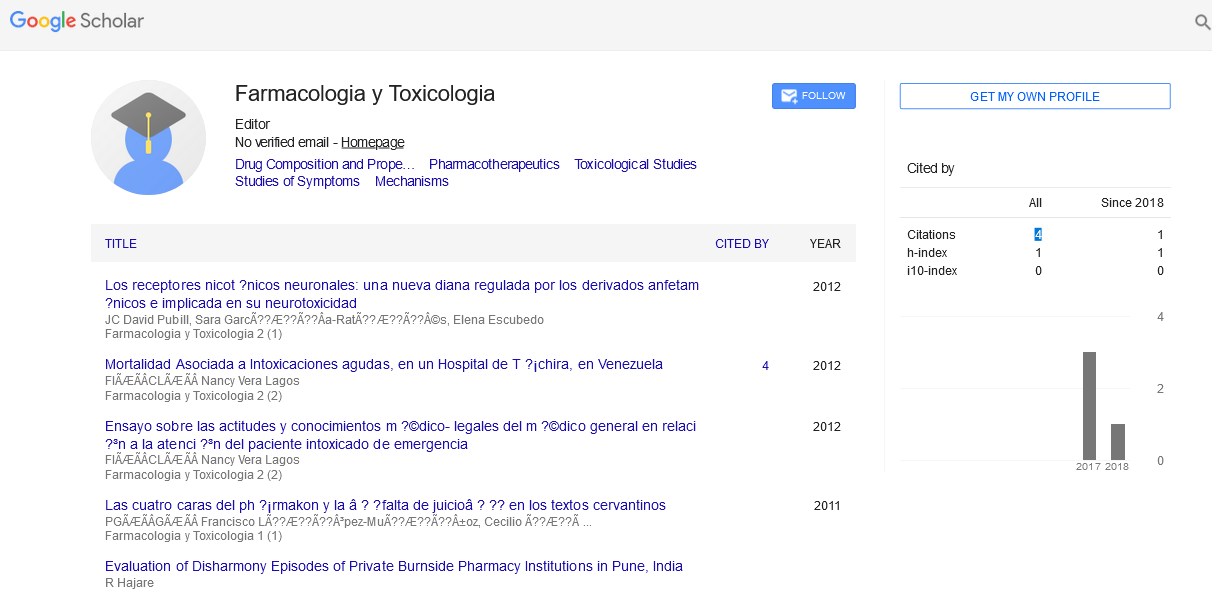Perspective - (2024) Volume 14, Issue 6
Exposure: The Condition of being Exposed to a Chemical, Physical or Biological Agent
Tabea Hammes*
Department of Toxicology, University of Maritime, Cairo, Egypt
*Correspondence:
Tabea Hammes, Department of Toxicology, University of Maritime, Cairo,
Egypt,
Email:
Received: 07-Aug-2024, Manuscript No. IPFT-24-15143;
Editor assigned: 12-Aug-2024, Pre QC No. IPFT-24-15143;
Reviewed: 26-Aug-2024, QC No. IPFT-24-15143;
Revised: 02-Dec-2024, Manuscript No. IPFT-24-15143;
Published:
30-Dec-2024
Introduction
Exposure is a fundamental concept in various scientific
disciplines, particularly in environmental science, pharmacology
and toxicology. It describes the state of an organism or system
being subjected to a chemical, physical or biological agent.
Understanding exposure is crucial for assessing risk, designing
protective measures and developing regulations to safeguard
health and the environment. This article delves into the nuances
of exposure, its types, implications and the methodologies used
to study and manage it.
Description
Types of exposure
Exposure can be categorized into several types based on the
nature of the agent and the mode of contact:
Chemical exposure: This occurs when an organism comes into
contact with chemicals, whether through inhalation, ingestion or
skin absorption. Chemicals can be naturally occurring or
synthetic and their effects depend on their concentration,
duration of exposure and the organism's sensitivity. For
example, exposure to pesticides in agriculture or pollutants in
industrial areas can have significant health implications.
Physical exposure: Physical agents include radiation (e.g.,
ultraviolet, ionizing), noise and temperature extremes. Physical
exposure can result in immediate effects, such as burns from
radiation or hearing loss from loud noises, as well as long-term
health impacts. Occupational settings often present risks of
physical exposure, requiring stringent safety measures to protect
workers.
Biological exposure: This involves contact with biological
agents such as bacteria, viruses, fungi or parasites. Biological
exposure is a major concern in healthcare settings, agriculture
and natural environments. Infections, allergic reactions and
zoonotic diseases (diseases transmitted from animals to
humans) are common outcomes of biological exposure.
Measuring exposure
Accurate measurement of exposure is essential for risk
assessment and regulatory purposes. The measurement process
involves several steps:
Identi ication of the agent: The first step is identifying the
chemical, physical or biological agent involved. This involves
understanding its properties, sources and potential pathways of
exposure.
Assessment of concentration: Determining the concentration
of the agent at the exposure site is crucial. For chemicals, this
might involve measuring pollutant levels in air or water. For
physical agents, it could involve assessing radiation levels or
noise intensity.
Evaluation of duration and frequency: Exposure is not only
about the concentration of the agent but also about how long
and how often the exposure occurs. This aspect helps in
understanding the dose-response relationship and potential
health effects.
Monitoring: Continuous or periodic monitoring may be
necessary to track changes in exposure levels over time. This can
involve using sensors, sampling techniques or biological markers.
Health implications
The health implications of exposure vary widely depending on
the nature of the agent, exposure levels and individual
susceptibility.
Chemical exposure: Chronic exposure to certain chemicals
can lead to long-term health effects, such as cancer, respiratory
issues or reproductive problems. For instance, exposure to
asbestos is linked to lung diseases, including mesothelioma.
Regulatory agencies often set permissible exposure limits to
minimize these risks.
Physical exposure: Prolonged exposure to high levels of noise
can cause hearing loss, while excessive exposure to ultraviolet
radiation increases the risk of skin cancer. Safety guidelines and
protective equipment are essential in mitigating these risks.
Biological exposure: Exposure to pathogenic microorganisms
can result in infections or diseases. For example, healthcare
workers are at risk of exposure to bloodborne pathogens,
necessitating the use of Personal Protective Equipment (PPE)
and strict hygiene practices.
Risk assessment and management
Assessing and managing exposure involves evaluating the
potential risks associated with exposure and implementing
strategies to reduce or eliminate these risks. This process
typically includes:
Risk assessment: This involves evaluating the likelihood of
adverse health effects occurring as a result of exposure. Risk
assessment takes into account the dose-response relationship,
exposure levels and population vulnerability.
Regulatory standards: Governments and regulatory agencies
establish standards and guidelines to protect public health. For
example, the Environmental Protection Agency (EPA) sets limits
on air and water pollutants, while occupational health agencies
provide safety standards for workplace exposures.
Preventive measures: Implementing preventive measures is
crucial for reducing exposure risks. These measures can include engineering controls (e.g., ventilation systems), administrative
controls (e.g., work practices) and personal protective
equipment (e.g., gloves, masks).
Public awareness: Educating the public about exposure risks
and safety practices is essential. Public awareness campaigns
can help individuals understand how to protect themselves and
reduce their exposure to harmful agents.
Conclusion
Exposure, the condition of being subjected to chemical,
physical or biological agents, plays a critical role in
understanding and managing health and environmental risks. By
measuring exposure accurately, assessing its implications and
implementing effective risk management strategies, we can
better protect individuals and communities from potential harm.
Ongoing research and advancements in technology continue to
enhance our ability to monitor and control exposure, ultimately
contributing to improved public health and safety.
Citation: Hammes T (2024) Exposure: The Condition of being Exposed to a Chemical, Physical or Biological Agent. Farmacologia Toxicologia, Vol.14
No.6: 058





